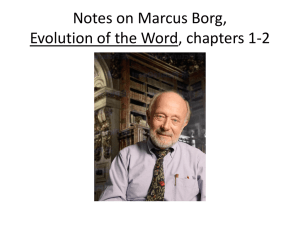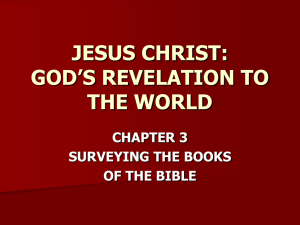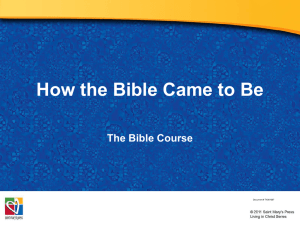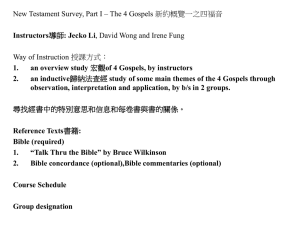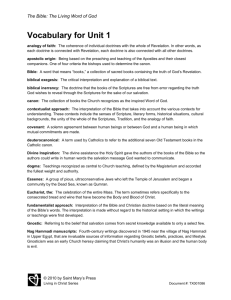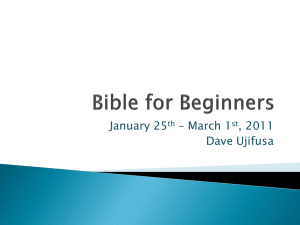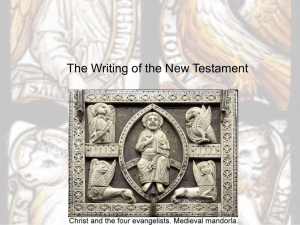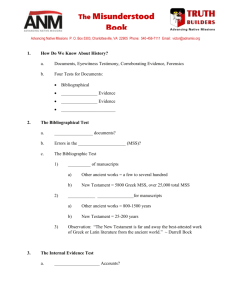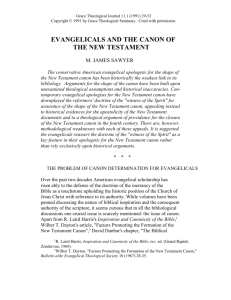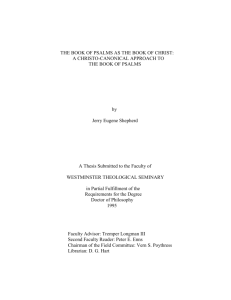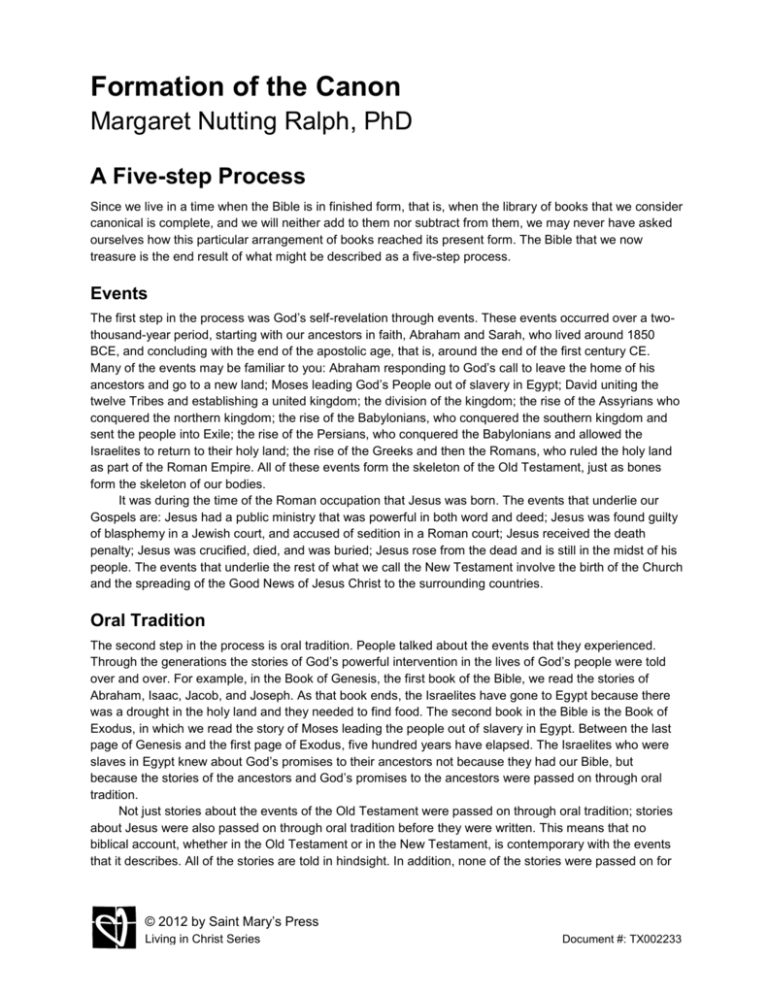
Formation of the Canon
Margaret Nutting Ralph, PhD
A Five-step Process
Since we live in a time when the Bible is in finished form, that is, when the library of books that we consider
canonical is complete, and we will neither add to them nor subtract from them, we may never have asked
ourselves how this particular arrangement of books reached its present form. The Bible that we now
treasure is the end result of what might be described as a five-step process.
Events
The first step in the process was God’s self-revelation through events. These events occurred over a twothousand-year period, starting with our ancestors in faith, Abraham and Sarah, who lived around 1850
BCE, and concluding with the end of the apostolic age, that is, around the end of the first century CE.
Many of the events may be familiar to you: Abraham responding to God’s call to leave the home of his
ancestors and go to a new land; Moses leading God’s People out of slavery in Egypt; David uniting the
twelve Tribes and establishing a united kingdom; the division of the kingdom; the rise of the Assyrians who
conquered the northern kingdom; the rise of the Babylonians, who conquered the southern kingdom and
sent the people into Exile; the rise of the Persians, who conquered the Babylonians and allowed the
Israelites to return to their holy land; the rise of the Greeks and then the Romans, who ruled the holy land
as part of the Roman Empire. All of these events form the skeleton of the Old Testament, just as bones
form the skeleton of our bodies.
It was during the time of the Roman occupation that Jesus was born. The events that underlie our
Gospels are: Jesus had a public ministry that was powerful in both word and deed; Jesus was found guilty
of blasphemy in a Jewish court, and accused of sedition in a Roman court; Jesus received the death
penalty; Jesus was crucified, died, and was buried; Jesus rose from the dead and is still in the midst of his
people. The events that underlie the rest of what we call the New Testament involve the birth of the Church
and the spreading of the Good News of Jesus Christ to the surrounding countries.
Oral Tradition
The second step in the process is oral tradition. People talked about the events that they experienced.
Through the generations the stories of God’s powerful intervention in the lives of God’s people were told
over and over. For example, in the Book of Genesis, the first book of the Bible, we read the stories of
Abraham, Isaac, Jacob, and Joseph. As that book ends, the Israelites have gone to Egypt because there
was a drought in the holy land and they needed to find food. The second book in the Bible is the Book of
Exodus, in which we read the story of Moses leading the people out of slavery in Egypt. Between the last
page of Genesis and the first page of Exodus, five hundred years have elapsed. The Israelites who were
slaves in Egypt knew about God’s promises to their ancestors not because they had our Bible, but
because the stories of the ancestors and God’s promises to the ancestors were passed on through oral
tradition.
Not just stories about the events of the Old Testament were passed on through oral tradition; stories
about Jesus were also passed on through oral tradition before they were written. This means that no
biblical account, whether in the Old Testament or in the New Testament, is contemporary with the events
that it describes. All of the stories are told in hindsight. In addition, none of the stories were passed on for
© 2012 by Saint Mary’s Press
Living in Christ Series
Document #: TX002233
Formation of the Canon
Page | 2
the purpose of teaching history. Rather, the stories are stories of faith; their purpose is to describe how
God has revealed God’s self through events.
The stories that developed to pass on the people’s understanding of God’s powerful presence in the
events of their lives could be in any literary form. After all, the stories were composed not to teach history
but to inspire each succeeding generation, to teach that generation that the promises made to Abraham
are promises made to them, and that because they are in a covenant relationship with God they have
certain obligations and responsibilities. Such lessons could be taught in any number of forms, including
legends, songs, fiction, allegories, parables, and riddles. Any literary form could be a vehicle to teach truth.
Written Tradition
Slowly, over time, some of the stories passed on through oral tradition began to be written down. If we had
lived during the time of Abraham (1850 BCE) or Moses (1250 BCE) we would not have been able to read
any part of our present-day Bible. However, if we had lived during the time of King David (1000 BCE), we
could have read some of our present Old Testament. At that time stories that had developed orally over
hundreds of years were gradually written down and collected into an organized narrative.
This same process underlies the New Testament. Had we been contemporaries of Jesus, we could
not have read our present New Testament. Had we lived during Paul’s lifetime we could not have read our
present-day Gospels, although we could have read Paul’s letters, the earliest New Testament material to
reach written form. Gospel materials, too, were passed on orally, and then in written form, before they
became the organized narratives that we have today.
Edited Tradition
Had we lived at the time of King David and read the organized narrative that dates to about 1000 BCE, we
would still not be reading the Book of Genesis or the Book of Exodus as those books now exist. Over time,
in the light of subsequent events, the stories were retold to include new insights or emphasize certain
points that were learned through the subsequent events. For instance, in the earliest collected narrative
that dates to the time of King David, the stories of the ancestors were told from the point of view of those
who lived in the south. When the kingdom split into north and south, the stories were retold from the point
of view of those in the northern kingdom. After the northern kingdom was conquered by the Assyrians,
those in the south pondered what the northern kingdom had done wrong. The stories were retold,
emphasizing the lessons stressed by the reformers who were calling the people to fidelity to their covenant
relationship with God. After the Babylonian Exile the stories were again retold in the light of what had been
learned from that experience. Our present Old Testament stories are layered. They reflect the thinking and
insights of the Israelites over the span of their history, not just the insights that are contemporary with the
original storytellers.
The New Testament is also an edited text. The author of the Gospel According to Luke describes
himself as an editor who is arranging the inherited oral and written traditions about events in order to meet
the needs of his particular audience (Lk 1:1–4). Also, the order of the books in the New Testament is not
the order in which the books were written. In our present edited arrangement, the Gospels come first, and
the letters, many of which were written earlier than the Gospels, follow.
© 2012 by Saint Mary’s Press
Living in Christ Series
Document #: TX002233
Formation of the Canon
Page | 3
Canonical
Not every book that developed through the process we have described is in the Bible. We call those books
that are in the Bible, canonical. The word canon originally referred to a reed that was used to measure
things, a ruler. The fact that a book is in the canon means that the believing community claims that this
book faithfully teaches those truths that God wishes to teach us for the sake of our salvation. The book is a
rule for our faith.
The selection of canonical books also developed slowly over time. The Old Testament canon, as we
now have it, is divided into three sections by Jewish scholars: the Law, the Prophets, and the Writings. We
see evidence of these divisions in the foreword to the Book of Sirach, which dates to the end of the second
century BCE: “Many important truths have been handed down to us though the law, the prophets, and the
later authors.” However, the Hebrew canon of the Jews, which Christians call the Old Testament, probably
did not reach its present form until the first century CE.
The Catholic Old Testament canon includes some books not included in the Jewish Hebrew canon or
in the Protestant canon. These books—Tobit, Judith, First and Second Maccabees, Wisdom, Sirach, and
Baruch—are called deuterocanonical books by Catholics and apocryphal books (i.e., not part of the canon)
by Protestants. All of the disputed books were written during the last few hundred years before Christ,
many of them in Greek. They became part of the Septuagint, that is, the Greek translation of the Hebrew
Scriptures. The Hebrew Scriptures were translated into Greek in the third century BCE because many
Jews lived in Egypt and spoke Greek rather than Hebrew. The deuterocanonical books appear in the
Catholic canon because Catholic biblical translations rested on both the Hebrew and Greek Old Testament
texts. They do not appear in Protestant canons because Protestant translations rested only on the Hebrew
Old Testament texts.
Catholics and Protestants have exactly the same New Testament canon. Again, not all of the books
about New Testament events are in the canon. There are apocryphal gospels that you are free to read.
However, by the end of the second century CE, the four Gospels that we now have were in general use,
and the others had fallen out of use. By the end of the fourth century, the whole New Testament canon as
we now have it had taken shape.
Christians believe that the formation of the canon was due to the work of the Holy Spirit in the
worshiping community. Those books that the community recognized as faithfully passing on the beliefs of
the community and nourishing the community remained in use; those that did not fell out of use.
The Catholic canon was officially closed in the sixteenth century at the Council of Trent. During the
Protestant Reformation, debate arose about whether or not all of the books that were then in use should
be considered canonical. In reaction to this discussion the Council affirmed that the New Testament books
that had been in use for fifteen hundred years and that had formed the self-understanding of the Church
were canonical. We would not add to them nor subtract from them.
This article is excerpted from Saint Mary’s Press® College Study Bible (Winona, MN: Saint Mary’s
Press, 2007). Copyright © 2007 by Saint Mary’s Press. All rights reserved.
© 2012 by Saint Mary’s Press
Living in Christ Series
Document #: TX002233

